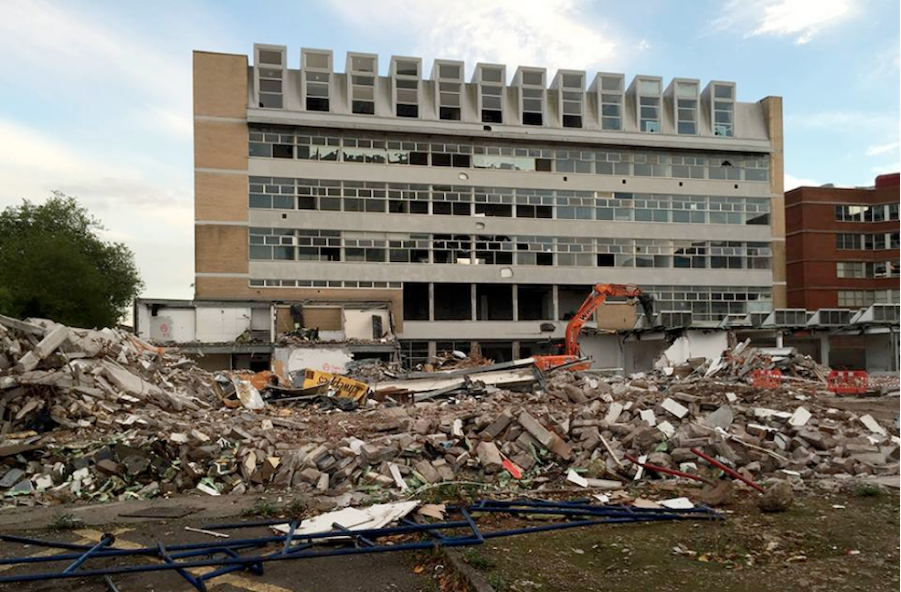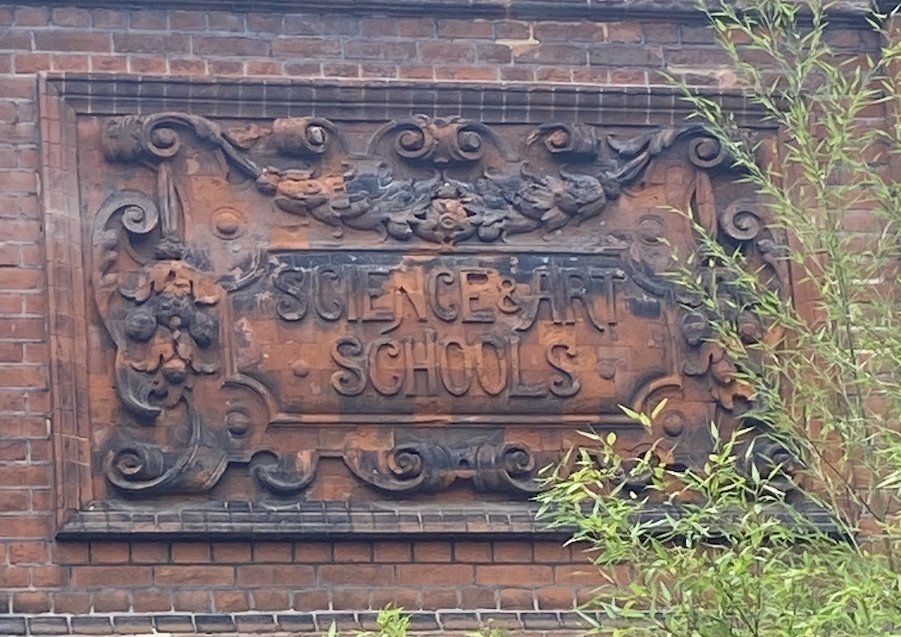MY OLD SCHOOL
The University of Wales Institute Cardiff, Howard Gardens, Cardiff, circa 2014
This was where I received my arts education between 1993 and 1996. These images were doing the rounds on social media sometime around 2014, and at this time, I would often start my public speaking engagements by showing them, referring to the demolition of these buildings as a metaphor for arts education being ‘in ruins’. Since then, out of the rubble has emerged a new building consisting of hotel-like accommodation for Cardiff Metropolitan University students; clean, sleek and well appointed, this new usage is as far from my own rough, dirty, chaotic art school experience as it is possible to imagine.
At the time I studied there, the Howard Gardens campus of the University of Wales Institute Cardiff was home to a genuinely unique visual art programme, creating a generation of British artists who did much to shape the direction of experimental performance in the UK in subsequent years. Dartington College of Arts in Devon had a similar status during this period. As a very particular convergence of artists, educators, learners, buildings and facilities, neither of these institutions exist anymore.
Why should they?, you might ask. Times change.
But other things have changed too, including the fact that my local education authority paid the entirety of my tuition fees when I began my degree in 1993. By the time I left the UK to work abroad in 2011, the tuition fee cap had just increased from £3,000 to £9,000. The final arc of this journey through arts education found me working for a decade in a private American art school (The School of the Art Institute of Chicago) where yearly tuition cost a student just over $50,000 a year. I soon realised that conversations with my American students about my experience of education relative to theirs were informed by a certain kind of guilt on my part.
When I first came to SPILL in 2021, I hadn’t realised that the Think Tank, our beautiful headquarters and venue, was housed in a building that once functioned as an art school; even though it is plainly stated as a plaque on the front of the building. Sometimes you just have to look up.
The Think Tank, High Street, Ipswich, 2023 (Photo, Robin Deacon)
Occasionally a guest to an event, or a passer by just popping their head around the door, will tell us that they used to do life drawing classes in what is now one of our meeting rooms. Gazing up at the vaulted ceilings with a wistful smile, they will regale us with their memories of the old Ipswich School of Art, an institution with alumni that include Maggi Hambling and Brian Eno. Luckily, as a listed building, it will not have the same fate as my alma mater, so these moments of reverie will still be possible in the future.
Why am I in such a reflective mood regarding the history (and future) of art schools and education? Perhaps because every other day it would seem there is a new article claiming there to be a devaluing of arts and creativity in school, or highlighting a shift away from the arts and humanities within university education. Of course, such observations are nothing new. I can’t remember a time when there haven’t been portrayals of creative arts courses as being, financially speaking, ‘not worth it’. Add the current high cost of living and a seemingly never ending spiral of inflation and these issues have an increased urgency.
I have been wondering what role SPILL might have in responding to these concerns. How can an experience of arts education be uncoupled from a lifetime of unreasonable debt? How can we question the idea of arts education as an indulgence or extravagance? What might we offer those who are creative, but do not believe a career in creativity is an economically viable path?
Over the last couple of months, my research has taken me to organisations like The Other MA (TOMA) in Southend, The Margate School and Open School East (also in Margate), to learn how others might be addressing these kinds of questions. In each instance, I saw a series of fascinating models for independent programmes of education that function outside of (and sometimes, in critique of) traditional forms and structures of institutional learning. In conversation with the directors of these programmes and some of their students, it was clear that all had completely different financial models and cultures of learning. But what was shared is a sense that something is awry in the way mainstream graduate and post-graduate educational provision in the UK is funded.
The Margate School (Formerly Woolworths), 31 - 33 High Street, Margate, 2023 (Photo, Robin Deacon)
Rightly or wrongly, I had always worked on the premise that artists were generated by educational institutions, whether in BA programmes like Cardiff where I studied, or postgraduate/MFA level at the School of the Art Institute in Chicago where I taught. As a lecturer or professor in both universities and art colleges, I was sometimes guilty of not giving a great deal of thought about what students experience before they reach higher education. In a recent Instagram post, British artist Bob and Roberta Smith claimed that in 2023, 40% fewer children took GCSE art than in 2010. If correct, this raises some interesting questions regarding what might be going on ‘downriver’.
Bob and Roberta Smith, Instagram post, 14 May 2023
Way back in the 1980s (having received utterly mediocre grades for all of my A-level exams), I remember telling my mother I was worried that I had made a horrible mistake having chosen to only take academic subjects, and really didn’t know what to do next.
History: D
English: E
Geography: U (Ungraded)
In response, my mum went on to do some research on my behalf (probably at the library; these were pre internet times), and came back with the suggestion that I could do a thing called an ‘art foundation’ course and this would be a way to get into art school. I followed her advice, gained entry to the BTEC Foundation Studies course at my local college, and at last, everything made sense again.
The question I have been asking myself of late is this: if I was now in my late teens or early twenties, would I still consider going to art school? What if my parents hadn’t encouraged me to follow a creative path? If there were other kinds of provision that were not so associated with debt and unstable career options, would I avail myself of them?
Counterfactuals of this kind can present us with infinite scenarios. But if I step outside of myself and apply these questions in the context of SPILL Festival (and in particular, the work we do at the Think Tank), a bigger picture starts to emerge. Some of the most memorable experiences I have had at SPILL in the last couple of years relate to the work we have done with artists that has opened up creative experiences for children. Most recently, Nottingham artist Bruce Asbestos spent a few days with us leading a series of workshops with Year 5 and 6 children who were charged with creating miniature monsters from clay. Bruce will fabricate some of the characters they created in larger form, to be shown in our October festival alongside his own enormous inflatable sculptures.
Bruce Asbestos, Ok Cherub, The Bluecoat, Liverpool, 2022 (Photo, Roy Battersby)
Bruce’s instructions to the children were simple and open ended, but he made an interesting clarification at the start. He said that if the task was to make an animal, the children would likely produce a predictable series of dogs or cats. But if the task is to make a monster, then the imagination can run riot. As Bruce pointed out, a monster can have twenty five legs or six eyes. It can be pink, green, blue, or a mixture of all these colours.
Clay ‘monsters’ made by year 5 and 6 pupils, St Matthews School, Ipswich (Photo, Robin Deacon)
Of course, Bruce’s workshops with these children are not ‘art school’, at least not in the sense that I have been writing about here. But what is the line to be drawn from these kinds of childhood experiences of making and the possibility of creativity still having a central significance in one’s adult life? As I wrote this question, I was suddenly reminded of an observation from the late, great British artist Brian Catling. In a 2021 BBC documentary about his life and work, he shared a childhood recollection of making something with clay, mud and sticks at school. As he remembers it, it was a model of a caveman’s house, and his realisation was the following:
‘There was something about getting dirty. You have to let the hands think. You don’t work it out with a pencil, you don’t work it out in your head; you put your hands in the material and see what happens. I don’t think that’s taught anymore. I don’t think that’s even discussed.’
It is important to remember that such creative revelations can also be found in the most unlikely of places. Might there be something to be said for activities and processes that happen outside the walls of educational institutions? All those solitary hours I spent as a child playing with Lego were no doubt creative - building objects, stories and worlds with my own hands. ‘Thinking with my hands’ indeed. In retrospect, I even think the time I spent doing menial warehouse jobs in my teens and early twenties was not unconnected to the kinds of repetitive actions over long durations that my educators in Cardiff would later claim to be ‘performance art’. Paradoxically, I sometimes wonder if not taking A-level art (of not learning how to draw) was what ultimately made me an artist.
Thanks to Leon Clowes, Polly Brannan (Open School East), Emma Edmondson (TOMA), Andrea Cunningham (METAL, Southend) and Maz Stuart (The Margate School) for their generosity and time, and thanks to Bruce Asbestos for his brilliant workshops.









